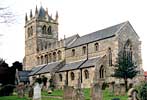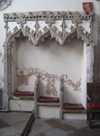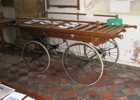For this church:    |
|
| IN LOVING MEMORY OF LIEU’T GERARD CHAMBERS TUNBRIDGE DIED OF WOUNDS IN BULGARIA, 27TH APRIL 1918 DURING THE GREAT WAR |
 Former Easter Former EasterSepulchre (now and aumbry) |
 As it was As it wasbefore doors added |
Easter Sepulchre (now aumbry)
In the chancel is the diminutive fourteenth century Easter Sepulchre, an upright niche with flowing tracery. It now has doors and serves as an aumbry.
Lentern Veil
In the chancel is a rare survival of evidence for a Lentern veil, used to screen the sanctuary during the period of Lent. It comprises a pulley, attached to the uppermost part of the sedilia, and a corresponding hook on the opposite wall.
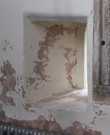 Squint
Squint
There is a hagioscope, which gave the priest at the south aisle chantry altar a view of the main altar. It is not datable exactly but may be of the 14th century.
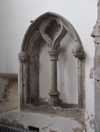 Double piscina
Double piscina
The 14th century double piscina has a central shaft, ogee-headed openings with Decorated tracery, hood mould, and mask stops.
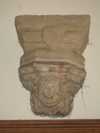 Stone bracket
Stone bracket
South of the altar is what appears to be an image bracket taking the form of an angel with a blank shield (perhaps once painted); there is also a plain bracket to the north of the altar which served the same function. Both appear 15th century.
 Chancel door
Chancel door
There is a narrow doorway linking the chancel with the north chapel. It is 14th century, ogee-headed.
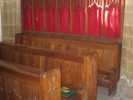 Stalls Stallsnorth side |
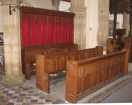 Stalls Stallssouth side |
Choir stalls
The two rows of choir stalls are on either side of the Chancel. They are backed by carved wooden screens and dedicated to Rev Henry Martin with the inscription:
In Memory of Henry Arthur Martin  Vicar of Laxton mdccclviii mdcccxcviii |
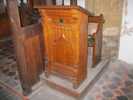 Priests’ stalls and Prayer desks
Priests’ stalls and Prayer desks
There is a single wooden Priest stall on either side of the Chancel. Both display the dedication:
| To the Glory of God and in Memory of Frank Willis for 40 years School Master and Organist of this Parish and Church Obit February 10th 1927 |
There is also a Prayer desk that is situated in the Chancel and has the dedication:
| To the Glory of God and in memory of Charles William Sydney, 4th Earl Manvers Obit July 17th 1926 From Parishioners of Laxton |
A second oak Prayer desk in the Chancel has the dedication:
| IN LOVING MEMORY OF REGINALD MARK ROSE 1926-2001 |
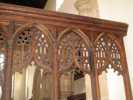 Detail of the screen Detail of the screen |
Chancel Screen
The chancel screen is of oak, 7 bays, dating from the 15th century, with ogee heads and Perpendicular traceried panels. It is heavily restored, probably in 1860.
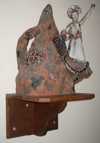 “Harrowing of Hell” model
“Harrowing of Hell” model
The Rev Richard Camenisch, Vicar of Laxton 1959-68, had this statue made by Stanislas Reychan. He had originally intended it to be larger, and to occupy the stone bracket on the north side of the altar. However it turned out to be too small for that location and so was placed on a wooden bracket in the south chancel aisle. It depicts the medieval story of the freeing of souls in hell by Christ immediately after his crucifixion.
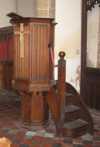 The pulpit The pulpit |
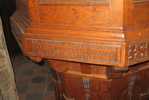 The dedication The dedicationinscription |
Pulpit
The pulpit, in oak, was given in memory of Rev Christopher Collinson:
| IN MEMORY OF CHRISTOPHER BARBER COLLINSON, PRIEST, VICAR OF LAXTON, 1898-1916 |
 Lectern
Lectern
The oak lectern was given in memory of Rev H A Martin:
| IN MEMORY OF H.A. MARTIN VICAR OF LAXTON 1858-1898 PRESENTED BY HIS PARISHIONERS AND FAMILY |
Pews
The church pews are nineteenth century oak, and probably date from the restoration in 1859-60.
 Font
Font
The font appears to be mainly 13th century in date, octagonal, with chamfered roll moulding. There appears to be some restoration, probably dating from the 19th century. However, the base clearly does not belong to the body of the font and appears to be part of a reduced and reused 13th century clustered column.
The wooden top commemorates the coronation of King George VI in 1937.
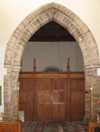 The west screen The west screen |
 Inscription on Inscription onthe screen |
West Screen
The oak screen separating the body of the church from the base of the tower is inscribed:
| TO COMMEMORATE THE SILVER JUBILEE ~ 1935 GIVEN BY THE PEOPLE OF LAXTON. |
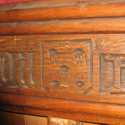 Carving of the Carving of the“Five wounds of Christ” on the north screen |
North Aisle Screen
The North Aisle Screen is inscribed:
| ROBERT de TRAFFORD Vicar of Laxton 1532 |
and also carries the words of the angel to Mary:
| Ave Maria, gratia plena |
Amidst the wording is a representation of the five wounds of Christ, a late medieval devotional symbol used particularly in the Pilgrimage of Grace, an uprising in 1536 against the reforms of Henry VIII.
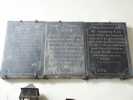 Benefactions Boards
Benefactions Boards
Three plaques on the south wall of the bell tower details benefactions given for the poor of the parish. They read:
SEPTEMBER THE XXV  T N TRUSWELL Sculp |
Anno Domini  L Truswell, sculp. |
May 9th MDCCCXXII  JTL |
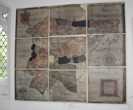 Plan of the Plan of thefield system |
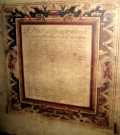 Detail of the Detail of theplan legend |
Field Plan and Terrier
On the south wall of the church is a large plan of the traditional field system (for which Laxton is best known). On the west wall is a terrier giving details of the acreage of all of the allocations.
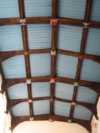 Nave roof
Nave roof
The nave roof has a mainly 15th century superstructure with elements of 1860 restoration including new boarding.
Flooring
The carved stones on the floor around the altar are probably medieval. The rest of the floor is red and blue Victorian tiles.
Other Items in the Church
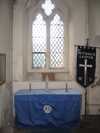 The north chapel The north chapel |
 Royal Royalproclamation |
 Madonna figure Madonna figure |


